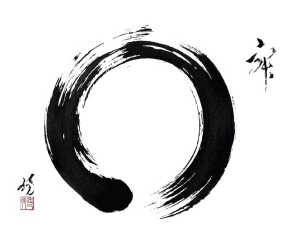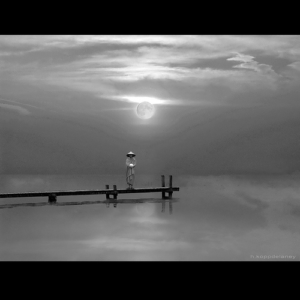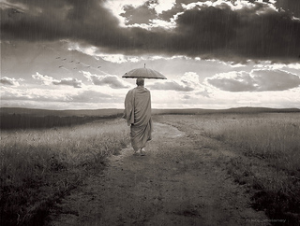Emptiness and Fullness by Bill Epperly
There are two essential capacities for awakening: emptiness and fullness. What I mean by emptiness is access to radical emptiness—abiding in the place where self can seemingly dissolve to nothing, where we are in the presence of nothing, and yet have the felt sense of tremendous presence that is pure potential. I want to contrast that with the idea of fullness, by which I mean the capacity for whole-hearted, whole body engagement with the world of form. I’d like to suggest that these two capacities, these two experiences, these two paths, are essential aspects of the spiritual path. If we think of emptiness and fullness as two different paths, they can seem to be diametrically opposed to each other. On one hand, we have the renunciate’s path of letting go and letting be, of diving into emptiness and letting the self-concept go. On the other hand, in the path of engagement, we have the absolute opposite. We pay attention to our thoughts, senses, and impulses, and work with them in a very fine way to try to bring new life into the world, not letting go so much as holding and bringing into life. While the two paths seem to go in opposite directions, as our spiritual development moves along, they converge and start to inform and enrich each other.

Many spiritual seekers tend to believe that the spiritual path is the way of letting go and letting be, the way of emptiness, of transcending the body-mind, maybe even trashing the body-mind or discounting it, and going for that transcendent experience. This attitude can be characterized by a real reticence, reluctance, or even refusal (in my own case, sometimes a refusal) to embody and take on life in the world. We can become addicted to the Samadhi quality and just want to go into emptiness, leaving the hard decisions of life in the world to other people.
As we take up the spiritual path, the journey into emptiness is often a focal point, and I think a really important one. In this journey, we typically take up a meditative practice. This is where the iAwake products, theProfound Meditation Program and other products, can really accelerate and catalyze our growth, giving us help in quieting our minds, inducing brain states that can also be cultivated through other forms of meditation, Zen, Centering Prayer, and so on, but PMP and other technologies bring us to that same state very quickly.
I think a key part of the journey is to practice letting go, letting go of the self-sense, letting go of the compulsion or the urge to act, sitting with ourselves, sitting with our minds, sitting with our bodies, sitting with the entirety of our life; we may wonder, as David Burns says, “What have I done?” To sit with that and create space to be with that which we are, and to submit to it all as it is, is the basis or the prerequisite to being able to respond skillfully to life in the most helpful way.

In this revelation of the self, we discover all the aspects of being that had been hidden right below the surface: the radiance and simplicity, the beauty of a simple moment; and we find that there’s a quality of being that transforms every potential, every mundane moment, into an ultimate moment of aliveness, an ultimate moment of fulfillment and meaning. It is right here—in a cup of tea, a glass of water, a smile, in dirt by the side of the road. Becoming informed through this type of exploration brings such richness back to our lives; our presence becomes infused with a depth and a capacity to be with our experience—to really see our lives and respond to them with great authenticity.
With time and practice, we can develop the capacity to bring an awareness of our spacious nature, of our no-self, or seemingly no-self nature into each moment. It is a tremendous gift to our normal waking consciousness to simply take one breath in the middle of the busy day and remind ourselves that, in the middle of Times Square or downtown Chicago, we are also vast emptiness and that our energy bodies expand outward in all directions in some mysterious way.
So, with our meditative training we develop better and more permanent access to these energetic bodies, to these states. During the Zen retreats I have attended, we would vow to turn form into emptiness. Then, five days later, we’d vow to turn emptiness back into form and turn the radiant consciousness—the vast, shimmering radiance that we’d become—back into appropriate form, structures, thoughts, containers, actions that were needed in the world, so that we could re-enter the world, re-enter the marketplace, as a bodhisattva, as a helping hand, as a person with bliss-bestowing hands. This is where the second capacity for fullness, or taking on form and engaging with form, comes into play.
I see the path to fullness, the path of engagement, as a developmental path. Here I particularly like the work of Susanne Cook-Greuter. Using empirical evidence, she has charted, recorded, and described the path that the self, the functional ego, takes from infancy to late adulthood, in a developmental journey that allows us to more and more fully take on and engage with life in the world of form. We are actually programmed by our very nature to develop toward a greater and greater capacity for fullness, for engagement. All that is really required, and it’s a big requirement, is that we follow the nascent intelligence, the body-mind intelligence of this and every moment exactly as it shows up.
The path to greater fullness is essentially a path for each of us to discover, because it’s a process of following a secret breadcrumb path that only we can perceive, that only we can decipher, make sense of, and respond to appropriately. No one else has access to our subjective interiors in the way that is necessary to receive the messages, receive the input, and discern the proper way to respond.
 As Susanne Cook-Greuter has mapped the sequence of events, later in our development we may come to a place of union of emptiness and form, where we feel able to engage with the world with great wholeheartedness and great commitment, and also with a wonderful sense of lightness; aware of the divine play that we’re part of, aware that as much as we believe our perspective, there are thousands of other ways to see and understand the situation, and that our piece, our answers, are only one part of a greater puzzle.
As Susanne Cook-Greuter has mapped the sequence of events, later in our development we may come to a place of union of emptiness and form, where we feel able to engage with the world with great wholeheartedness and great commitment, and also with a wonderful sense of lightness; aware of the divine play that we’re part of, aware that as much as we believe our perspective, there are thousands of other ways to see and understand the situation, and that our piece, our answers, are only one part of a greater puzzle.
So, as we think about the path of radical emptiness, the paradox is that in our experience of nothingness we can simultaneously feel that every potential action is present. In the life of fullness, the life of engagement, the paradox we experience is that in one specific action—in making a pot of cranberry sauce for Thanksgiving (there are thousands of different dishes I could make for Thanksgiving; do I have to make them all? No)—is the fulfillment of everything I need to do for Thanksgiving. Everything is contained in this one action.
When these two paths come together, they do so in a very beautiful, mysterious way, with emptiness informing the life of fullness and the life of fullness informing the experience of emptiness; emptiness is full and fullness is ultimately empty. Once these two capacities are established—and they’re not ends in themselves, they’re capacities—then we can naturally flow between the two poles, from form to emptiness, as seems appropriate in the moment. This brings much richness to life.
photo credits: h.koppdelaney via photopin
Adapted from iAwake’s webinar series with Guest Speaker Dr. Bill Epperly, November 2012.
Leave your comments below
1 Comments
Leave a Comment
You must be logged in to post a comment.

[…] In addition, this profound energetic connection helps provide the fullness that is often missing in modern spiritual practice, where an individual may be too focused on emptiness and detachment, to the point of lacking compassion. Bill Epperly wrote a great blog outlining the importance of balancing emptiness with fullness which can be read here. […]